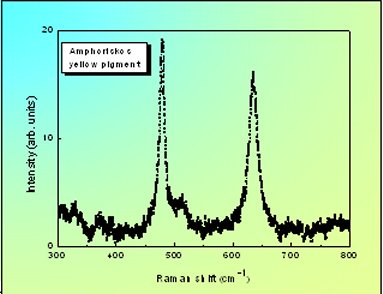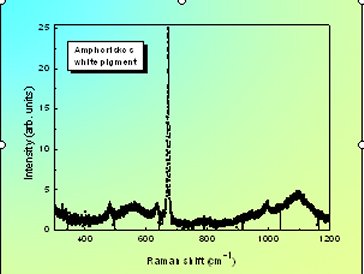The use of coloured materials has represented the deep necessity for a more defined representation of reality and for an enrichment of images. This use improves as time goes together with the development of knowledge and experience until nowadays. A number of different coloured substances, organic and inorganic one, has been used in the time to realize decorations on every kind of objects: amphoras, glass materials, medieval manuscripts, wall paint and so on. Nevertheless, the characterization of a pigment is in general a very complex "object". A pictorial mixture, in fact, may be constitute of a single pigment or of a blend of different pigments and binders depending on the colouristic need of artist and of its school. This scenario suggests the necessity to use a particularly sensitive technique able to distinguish a single pigment dispersed in a more complex mixture. The use of chemical and physical methodologies, in particular the spectroscopic ones, is now attracting interest in the field of cultural heritage and conservation; the physical-chemical characterization of materials, in fact, represents a very precious tool in order to obtain useful information about the execution techniques used in the past, the dating and the authentication which contribute to a full historical scenario of the artefact together with a analysis of deterioration processes. The use of Raman microspectroscopy as single technique, has been able to give us useful and resolutive information An archaeometric investigation has been perfomed on a glassy dark-blue past amphoriskos recovered in a grave in San Marco d'Alunzio (dated to III century B.C Sicily; Italy) probably used at the time as perfume bottle. The object, shown in the photo, was part of a the funerary equipment results finely decorated with superimposed white and yellow lines. The aim of the work has been the identification of chromophores used in the realization of external decorative motif and responsible of blue coloration of glassy paste substrata of amphoriskos itself. Yellow decorative motif seems, to naked eye, enough homogenous, but from a microscopic inspection reveals the presence of areas of strong in-homogeneity. This circumstance make consistent the hypothesis that the yellow coloration can be assigned to a single pigment but to a mixture of pigments (yellow and white). Micro Raman analysis have been performed with a mapping procedure in order to put into evidence and discriminate the different substances responsible of the studied coloration. The experimental Raman spectrum in figure shows the characteristic bands of lead oxide located at about 480 cm-1, mixed to antimony oxide that acts as lightening of tonality. White decorative line appears enough homogenous from a microscopic inspection, this finding has been confirmed by the spectral analysis which reveals the presence of only a component: the antimony oxide which characteristic peak is centred at about 670 cm-1. The present study represents only a part of a wide contest of investigations which goal is in one way the characterization of various pigments used in the realization of the decorative motif of the object under study, but more in general we try to identify the manufacture techniques used for different objects realized in glassy paste: mosaic tesserae, for an example, recovered in the same excavation area and probably coeval of the amphoriskos analyzed in this report.
Vedi anche:
Immagini:


